|
In 1779, William Blake enrolled at the Royal Academy of Arts, which at the time was situated in Old Somerset House. He may have attended with one of his brothers, Robert, whose illustrations are briefly featured in the exhibition. The Royal Academy taught its students to draw by studying and copying classical sculptures, prints, live models and paintings, such as those by Peter Paul Rubens (1577-1640). Blake, on the other hand, rejected these teachings, preferring to use artworks by classical artists, such as Michelangelo (1475-1564) and Raphael (1483-1520). Despite rebelling against the traditional teaching methods, Blake participated in six exhibitions at the Royal Academy. Unfortunately, since he did not conform to the typical oil paint-format the Academy expected, Blake’s watercolours were often consigned to a smaller room. Students were encouraged to paint serious subject matters, often resulting in portraits and landscapes. Blake, on the other hand, chose to focus on Biblical stories, for instance, the story of Joseph and his brothers. Written in the Book of Genesis, Joseph had been sold into slavery by his jealous brothers. The series of events that follow result in Joseph having significant authority in the land of Egypt and, during a famine, his brothers end up begging him for help. Blake produced three watercolours that express the latter part of the story of Joseph. In the first, the brothers, unaware who Joseph is, bow down before him, pleading for help to survive the famine. The second, Joseph Ordering Simeon to be bound, shows one of Joseph’s older brothers willingly being arrested for a crime he did not commit to spare the life of another brother. Noting that the attitudes of his brothers have changed since they sold him into slavery, Joseph reveals his true identity and welcomes his brothers with open arms, as shown in Blake’s third painting. Read the full article here This blog post was published with the permission of the author, Hazel Stainer. www.hazelstainer.wordpress.com
0 Comments
This continues on from the Plumb Lines sermon. Reading: Mark 6:14-29 New International Version 14 King Herod heard about this, for Jesus’ name had become well known. Some were saying, “John the Baptist has been raised from the dead, and that is why miraculous powers are at work in him.” 15 Others said, “He is Elijah.” And still others claimed, “He is a prophet, like one of the prophets of long ago.” 16 But when Herod heard this, he said, “John, whom I beheaded, has been raised from the dead!” 17 For Herod himself had given orders to have John arrested, and he had him bound and put in prison. He did this because of Herodias, his brother Philip’s wife, whom he had married. 18 For John had been saying to Herod, “It is not lawful for you to have your brother’s wife.” 19 So Herodias nursed a grudge against John and wanted to kill him. But she was not able to, 20 because Herod feared John and protected him, knowing him to be a righteous and holy man. When Herod heard John, he was greatly puzzled; yet he liked to listen to him. 21 Finally the opportune time came. On his birthday Herod gave a banquet for his high officials and military commanders and the leading men of Galilee. 22 When the daughter of Herodias came in and danced, she pleased Herod and his dinner guests. The king said to the girl, “Ask me for anything you want, and I’ll give it to you.” 23 And he promised her with an oath, “Whatever you ask I will give you, up to half my kingdom.” 24 She went out and said to her mother, “What shall I ask for?” “The head of John the Baptist,” she answered. 25 At once the girl hurried in to the king with the request: “I want you to give me right now the head of John the Baptist on a platter.” 26 The king was greatly distressed, but because of his oaths and his dinner guests, he did not want to refuse her. 27 So he immediately sent an executioner with orders to bring John’s head. The man went, beheaded John in the prison, 28 and brought back his head on a platter. He presented it to the girl, and she gave it to her mother. 29 On hearing of this, John’s disciples came and took his body and laid it in a tomb. There are three Herods in the Bible, and they all get confused with one another. The first Herod was Herod the Great. He is the Herod who was around at the Nativity of Christ. Herod the Great got his power from Emperor Augustus. He was a builder and built many great things, but he was evil. He had, we believe, nine wives and many concubines, but then when someone has as much power as Herod the Great, they can do anything. Israel was ruled by the Romans, so Herod had to be friends with Augustus, who gave him the kingship. Herod Antipas was never king but he is the Herod in this story from Mark. He was full of ambition, paranoia and took after his father, Herod the Great. His father killed three of his sons, one of his wives, and his brother. He was just ruthless because he believed they were taking power from him. Interestingly enough, Herodias, the wife of Antipas, was the granddaughter of Herod the Great, who had killed her mother. Herodias was used to living in a situation where family members were killed and I wonder whether or not that in some way influences her behaviour. The third Herod, who we hear about in Acts, is Herod Agrippa who kills James. There are stacks of things that we can learn by reading this passage in Mark 6. All the time, the Bible is teaching us and trying to make us better people. When we read this passage, remember that Herod was not a real King. He never actually had the title King. This passage is the longest passage within the Gospel that does not have Jesus as its central point. So, why does Mark include it? Instead of Jesus, it relates to John the Baptist, but it must have been very important for Mark. A lot of history confirms much of what Mark says. The main author is Josephus (Joseph Ben Mathias), a Jewish historian who records these events outside of the Bible. Josephus tells us that Herod murdered John the Baptist. There is no mention of Herodias or Salome, who the Bible does not name but Josephus does, actually having anything to do with the murder of John the Baptist. But Mark is of a different opinion and Herod, whilst a bad man does not come out of it too badly. Mark has put the total blame onto the women. Mark is not anti-women, and we have had two powerful women in Mark 5 and 7 to prove this, but in this story, whilst Herod’s pride destroys things, he does not come over as being a very, very bad person. And this is where the plumb line in Amos 7 comes in. God's plumb line probably says Herod is bad, whereas other people may disagree. John is imprisoned in the same place as Herod’s banquet. At the banquet, the women are on one side and the men are on the other. This is a bit like the 18th and 19th century where the men withdraw to drink port and the girls and the women talk about knitting patterns or whatever affairs they are interested in. So, we have this separation at this banquet. Herod sat with the people he wanted to impress, and how Herod impressed people was by having risque parties while the women were somewhere else. To impress his court, Herod asked a young woman, who Josephus names Salome, to do a dance. She danced to seduce the men, and she was probably only 12 or 13 years old. So pleased was Herod with her performance, he offered the girl anything she wanted. He even offered half his kingdom, which was not his to give as he was not actually a king. The girl, who was Herodias’ daughter, asked her mother what she should request. Herodias really hated John the Baptist, because he told everybody that her relationship with Herod was wrong. Not only was she Herod’s niece, she was also married to his brother, Philip I. As far as the Jewish were concerned, this was incest and adultery, which John told her. Although this was the truth, Herodias was very upset. What do people do with the truth? Remember the reading in Amos? Do we ignore the truth or do we get rid of the messenger? Herodias did the latter, saying to her daughter, ask for John's head on a platter. So, the daughter went to Herod, and said she wanted John the Baptist’s head on a platter. According to Mark, but not necessarily in history, Herod is crestfallen. The word Mark uses is the same word Jesus used when praying in Gethseme. His soul was heartbroken. Pride stopped Herod from going back on his word, so he delivered. John was an innocent victim of a power game. I want to conclude by asking, if we were part of this gathering, who are we? Are we Herod, full of pride, not wanting to go back on our word for fear of losing face. Are we Herodias, a victim of their upbringing and of murderous intent? Are we like the girl, being manipulated? Or are we the other party-goers, who see this happening, but do nothing to stop it. I think we would be like the party-goers, not doing anything to stop it but still thinking it is wrong. This passage is challenging us today in a similar way. Whenever we see something that is not right, are we going to be like the party-goers, and not do anything about it, or are we going to stand up for what is true? But standing up for what is true got Amos condemned, got John the Baptist condemned, and got Jesus condemned. Eleven of the Twelve Disciples, or twelve of the thirteen if you include Matthias, died horrible deaths because they spoke the truth. The cost of discipleship is high, but Mark challenges us to take our place in the party and think about what role we play. Are we going to be perpetrators of violence or observers of violence? There are lots of good people out there, but they have not stopped many of the world’s atrocities. There were lots of good Germans, but they never stopped Hitler. There were lots of good Chinese people out there but they never stopped Mao Zedong. There are lots of wonderful Russians, but they never stopped Stalin. There are lots of good people out there today, but they do not stop the violence by speaking out. A question I always ask myself is what scars have I got to show because of my Christian faith? Have I spoken out when I have seen an injustice? Is my moral plumbline askew from God’s? Perhaps we should all ask those questions. This sermon was first preached at Wanstead URC by Reverend Martin Wheadon on 11th July 2021
The Virgin of the Rocks, sometimes known as Madonna of the Rocks, is the title of two paintings by Leonardo da Vinci. They both depict the same scene: the Madonna and Child Jesus with the infant John the Baptist and an angel in a rocky setting; however, there are a few significant differences, for example, the direction of the angel’s gaze. The original version, or at least the version considered to be the eldest, hangs in the Louvre in Paris, the other, hangs in the National Gallery and was the subject of the Leonardo exhibition. Leonardo was commissioned to paint The Virgin of the Rocks shortly after his move to Milan in the early 1480s. Having established his painting career in Florence, Leonardo had moved to search for new opportunities, which he found at the church of S. Francesco Grande. On 25th April 1483, Prior Bartolomeo Scoreline contracted Leonardo to produce painted panels for the new altarpiece in the Chapel of the Immaculate Conception that was attached to the church. Leonardo was contracted as the “master” of the project with brothers Ambrogio and Evangelista de Predis as his assistants. The artists were instructed on the colours and subject of the paintings. The central panel was to be of the Virgin Mary and Christ child with two prophets, perhaps David and Isaiah, surrounded by angels. Another panel was to show the Virgin Mary with God the panels to the side of the main painting were to contain angelic musicians. The job was to be completed by 8th December 1483, the Feast Day of the Immaculate Conception. As can be seen when looking at both versions of the painting, Leonardo did not stick to the instructions. Only one angel is present in the scene and there are no prophets except for the child John the Baptist. The church was not happy with the work Leonardo had produced by the completion deadline, therefore, he continued to work on it for a further five years until they were satisfied. Unfortunately, there was a dispute over payment so Leonardo, whether from spite or the need for money, sold the painting, which has eventually found itself in the Louvre. Leonardo was allowed to begin a second version, which was installed in the chapel in 1508. The subject of the two paintings, which was not what the church had originally requested, is the adoration of the Christ child by the infant John the Baptist. Although it depicts Biblical characters, the scene is not an event that features in the Bible. The Gospel of Matthew reports that Joseph, Mary’s husband, was warned by an angel in a dream about King Herod the Great who had ordered that “all the male children in Bethlehem and in all that region who were two years old or under” were to be killed. (Matthew 2:16 ESV) Therefore, Joseph fled to Egypt with his wife and Jesus. Several non-Biblical stories explain the flight to Egypt in more detail. One such story claims John the Baptist, Jesus’ cousin, was also staying with his family in Bethlehem where the Massacre of the Innocents was about to take place. Whilst the Holy Family made their way to Egypt after the angel’s warning, John the Baptist was escorted there by the Archangel Uriel, where he met his aunt and cousin on the road. It is this scene that Leonardo painted, therefore, it is assumed the angel he depicted is Uriel. Similar stories, however, claim the angel was Gabriel. It is not certain whose idea it was to deviate from the original contract but Leonardo had just come from Florence, whose patron saint was John the Baptist. Many religious artworks produced in Renaissance Florence involved the Christ child with John the Baptist, therefore, it may have only been natural for Leonardo to include the future preacher in his painting. Read the rest of the article here This blog post was published with the permission of the author, Hazel Stainer. www.hazelstainer.wordpress.com
Reading: Amos 7:7-15 New International Version 7 This is what he showed me: The Lord was standing by a wall that had been built true to plumb, with a plumb line in his hand. 8 And the Lord asked me, “What do you see, Amos?” “A plumb line,” I replied. Then the Lord said, “Look, I am setting a plumb line among my people Israel; I will spare them no longer. 9 “The high places of Isaac will be destroyed and the sanctuaries of Israel will be ruined; with my sword I will rise against the house of Jeroboam.” 10 Then Amaziah the priest of Bethel sent a message to Jeroboam king of Israel: “Amos is raising a conspiracy against you in the very heart of Israel. The land cannot bear all his words. 11 For this is what Amos is saying: “‘Jeroboam will die by the sword, and Israel will surely go into exile, away from their native land.’” 12 Then Amaziah said to Amos, “Get out, you seer! Go back to the land of Judah. Earn your bread there and do your prophesying there. 13 Don’t prophesy anymore at Bethel, because this is the king’s sanctuary and the temple of the kingdom.” 14 Amos answered Amaziah, “I was neither a prophet nor the son of a prophet, but I was a shepherd, and I also took care of sycamore-fig trees. 15 But the Lord took me from tending the flock and said to me, ‘Go, prophesy to my people Israel.’ There are various questions that strike us during this reading. We have to remember Amos was actually a poor shepherd. He had not been trained, he had not gone to Northern College or Westminster College or anything like that. He was just obedient. That is one of the key things about God; God does not necessarily use the most intelligent people, he uses those who are most obedient. It is availability, not ability, that God looks for. Amos was very much in that camp. He was obedient and he was available. Amos gives some very unpopular messages. The Lord tells Amos that he must set a plumb line. As we all know, a plumb line is a weight on the end of a rope or piece of string, which gives you a perfectly straight line. God is comparing the plumb line with God’s moral values - the things that God believes and to which people must adhere. This plumb line gives us a measure of what God believes in, as does the Bible. Now, if I made a plumb line, how skewed would my plumb line be in comparison to Gods? My moral values have been forged by friends, family, society, television, and social media. My plumb line resembles what I think is true, but how true is it compared to Gods? Luckily, God has given us his plumb line in the Bible, which tells us what to measure as the truth. God is very clear in the Bible that God does not like poverty, does not like people being oppressed, and is not happy when people manipulate and take advantage. When we think about how good our actions have been, we need to compare them to how good God thinks we have been. There is God's plumb line, there is a society's plumb line and there is our plumb line, but sometimes, they are not all the same measurements. In this reading, we have Amaziah, the chief priest of Bethel, and King Jeroboam, who ruled over the northern kingdom. King Jeroboam stopped people from the northern kingdom from going to the southern kingdom where Jerusalem was, yet everyone was expected to go to Jerusalem to fulfil their sacrifices and so forth. So, what King Jeroboam did was provide two other temples for his people to worship God. Amaziah was a priest assigned to one of these temples, which was Bethel. The other one was in a place called Dan. Amos has been asked to give Amaziah some bad news. The northern kingdom was not behaving as it should, so they would be annihilated. It is important to remember this book was written around 760 BC, because in 721 BC, Assyria invaded the northern kingdom and wiped it out. What we are reading is a prophecy from Amos, 40 years before the event. What happens when you hear the truth? Amaziah had two options. The first is to ignore Amos and believe the message does not relate to him or means something else. Secondly, he could get rid of the messenger, and that is what Amaziah did. He did not like what he was hearing and thought Amos was bad for morale, so asked Amos to go away. But Amos said, I can go away, but the truth remains the same. Unless they change their ways, they will be destroyed. The message we can take from this passage is, where do we set our plumb line? What is the cost of our discipleship? If we have to say something, which we know others will not like to hear, what should we do? The Cost of Discipleship is a book written by Dietrich Bonhoeffer. It is a lightweight book but it has heavyweight content. Bonhoeffer says that the cost of discipleship is, if you go to heaven, what scars will you be proud to show that you have sustained because of God. So, this passage examines us. It asks, what is the cost of our discipleship? Then we have to ask ourselves, what comes between us and obeying God? What obstacles do we put in the way to prevent us from obeying the word of God? This sermon was first preached at Wanstead URC by Reverend Martin Wheadon on 18th July 2021
Reading: Mark 6:1-1 (New International Version) Jesus left there and went to his hometown, accompanied by his disciples. 2 When the Sabbath came, he began to teach in the synagogue, and many who heard him were amazed. “Where did this man get these things?” they asked. “What’s this wisdom that has been given him? What are these remarkable miracles he is performing? 3 Isn’t this the carpenter? Isn’t this Mary’s son and the brother of James, Joseph, Judas and Simon? Aren’t his sisters here with us?” And they took offense at him. 4 Jesus said to them, “A prophet is not without honor except in his own town, among his relatives and in his own home.” 5 He could not do any miracles there, except lay his hands on a few sick people and heal them. 6 He was amazed at their lack of faith. Then Jesus went around teaching from village to village. 7 Calling the Twelve to him, he began to send them out two by two and gave them authority over impure spirits. 8 These were his instructions: “Take nothing for the journey except a staff—no bread, no bag, no money in your belts. 9 Wear sandals but not an extra shirt. 10 Whenever you enter a house, stay there until you leave that town. 11 And if any place will not welcome you or listen to you, leave that place and shake the dust off your feet as a testimony against them.” 12 They went out and preached that people should repent. 13 They drove out many demons and anointed many sick people with oil and healed them. This story should be read in conjunction with the earlier episode in Mark 3 where Jesus is rejected. In Mark 6, Jesus is speaking in his hometown, Nazareth, in a synagogue, a place where he should feel safe and secure. In Mark 5, he raised Jairus’ daughter. He was able to do the most amazing miracles, even raising people from the dead, no wonder crowds surrounded him. In Nazareth, he was preaching to people he knew, so thought it would be a good audience. But because they knew him, they did not believe the things he said. To them, he was only a carpenter, a local boy. They were prejudiced against seeing the truth. I wonder what blinds us from seeing the true person. Is it because we label them, and that we have our own prejudices? Prophets were workers for God, and here, Jesus is rejected in his own home town. How do we cope with rejection? Does it stop us? Should Jesus have said, “well as I've been rejected, I'm not going to go on”? Or did it not stop him, but just continue with such self-confidence knowing that his ministry was so important? It is interesting that the lack of miracles coincides with the idea of Nazareth having no faith. This means that faith and miracles must in some way be connected. In chapter seven, Jesus sends the apostles out in pairs, and not just in order to drive out evil spirits and heal sick people. He sent them out with very little: no extra shoes, no money, just a stick, meaning they had to be reliant upon the people they met. Their trust in God would have been enhanced. They would have had some bad experiences, no doubt they faced rejection, but also some good experiences. Some people would have accepted them, allowing them to perform healings and exorcisms. So, the disciples learned to trust in God with their meagre list of resources. The apostles became vulnerable and in many ways, this vulnerability meant that hospitality was forthcoming. Perhaps if they had gone out showing their wealth and expensive clothes, their message would have been overshadowed, but because they went with very little, the only thing to focus on was the message: repent from your sins; Jesus can forgive sins; there is a new way for salvation. The great thing about this story is Jesus’ humanity. Here we have Jesus, the human Jesus, who has a hometown, a place where he was able to lay his roots, a place where he was a carpenter. Interestingly, in this version, Jesus was the carpenter rather than the son of a carpenter. The people Mark wrote about saw him as a workman, but he is not appreciated or accepted. This is the God of the universe being rejected. They took offence at him. How could the next-door neighbour be the Son of God, especially as they have seen him grow up? His brothers and sisters are mentioned, but not Joseph, the father, suggesting, as I read in a commentary, the people thought Jesus was illegitimate. What makes this story important to me is this rejection by the family, both in Mark 3 and in Mark 6, which shows that when Jesus was alive, his family did not really understand him. Yet, after the resurrection, they did. We have two references, one in Acts 1:13-14 and one in Galatians 1:19, where the brothers of Jesus became prominent in the new Christianity. So, after the resurrection, they must have been one of the 500 who saw Jesus’ transformation. One brother, Jude, writes a letter, which becomes one of the 27 books in the New Testament. Another brother, James, becomes head of the church in Jerusalem. So, these brothers are prominent in the new Christianity, but they had previously rejected him. In Mark 3, they called him crazy, that he was beside himself. So, we have this wonderful story where these brothers did not believe, but in Acts and Galatians, their attitudes changed and they did believe in Jesus. The other thing to note is, if we do not understand somebody, we will tend to demonise them. So, Jesus was derided because he was a carpenter, and people could not see beyond that label to the bigger picture. This story is true because it is quite embarrassing. If you were trying to create a superhero, you would not let him be rejected by his family. You would not have these vulnerabilities. Yet, somehow, his power to heal was limited to the amount of faith the person had. This embarrassment tends to suggest that it is true. It is difficult because I like my superheroes to be flawless. I do not like them to have weaknesses, but here we have the Son of God, with weaknesses. Fully divine, fully human, but within that humanity, he cannot heal everybody. Another thing to mention is Jesus’s mother, Mary, and perpetual virginity. I have read that within the Roman Catholic Church, and within Islam, Mary could not have any more children, because she was a perpetual virgin. So where do these brothers and sisters come from? Within the Protestant Church, we believe that they were Mary’s because she was married to Joseph, but the Roman Catholics and Muslims say that they must have been from Joseph’s previous relationship. In this case, Jesus’ family are step-brothers. They still rejected Jesus, but still transformed after the resurrection. The reading is also mentioned in both Matthew 13 and Luke 4. There are slight changes within the narrative, but because it is in the three Synoptics, it makes you believe that it is a true story. We can learn a lot of truth from this passage. We learn that we demonise those that we do not understand. It also gives us some comfort in knowing that, when we try to preach and express our testimonies, and our words fall on ears that do not really want to hear the message, that the same thing happened to Jesus. The same thing happened to the apostles, the early disciples. So, it gives us some hope that, if even Jesus can not get his message across, then we are in good company when we fail. Of course, some people do not want to accept the truth because it is very inconvenient. It is costly to follow Jesus, his ways, values and morals. A costly suggestion in Acts is that we give our possessions to the poor, but, of course, Jesus was not against people having possessions. In Acts, there are lots of people, for example, Lydia, who were able to create wealth and use the wealth in order to help the disciples. So, Jesus is not against the acquisition of wealth, he is suggesting how we use it and questioning our motives. If we can use it for the furtherance of the kingdom, then that is okay. It is worth looking back at Mark 3:20-35, where Jesus heals on the Sabbath. The scribes who come to test Jesus cannot say that the miracles did not happen. Instead, they say Jesus must be possessed by the devil or working for the devil. So, Jesus’ Galilean ministry of healing, exorcisms, teaching, miracles and radical thinking, which upset people’s traditional values, must have happened otherwise the scribes would have claimed the miracles did not happen and offer proof. So, when people argue that Jesus did not exist, we have this wonderful story where we can reveal Jesus did, in fact, exist. When people say there is no evidence of Jesus existing, they forget to look at the evidence that is outside the Bible. If we look at that, we appreciate that the basic storyline is confirmed by non-Christian sources, such as Josephus the Jewish historian, Tacitus, Suetonius, Aeneas, Pliny the Younger, Trojan, and the Greek writer Lucien. All of these writers, outside the Bible, confirm the basic storyline of Jesus. Therefore, we do not have to rely upon the Bible in order to know that Jesus existed. So, this story in Mark 3 and Mark 6, embarrassing as it is, proves to me that miracles did happen. So we should not be embarrassed. It proves to me that Jesus was a real person. He was struggling, his family was embarrassed by him. But Jesus does not panic, he responds calmly. He makes us think about our values and suggests that perhaps the family we are born into is not the family we necessarily deserve. It is the people who believe that Jesus considers family. Of course, we know that the brothers do respond after the resurrection in the most magnificent way. They move from Jesus being an embarrassment to being the source of their salvation. The other thing about Jesus is that he is able to forgive sins. This of course is a very radical thought. By whose authority is he able to forgive sins? How dare he forgive somebody’s sins? It is not really Jesus’ place to do that! Yet, he claims that he can forgive sins. The fact that the story of Mark 3 and Mark 6 has the humanity of Jesus coming through, and the truth of Jesus coming through, makes this a real person. We remember that in John 6:66, many disciples turned back and could no longer follow him, because Jesus’ message is a hard message. Even Jesus could not convert everybody. But in John 6:68, Peter says, “You have the words of eternal life”, and that is vital. It is important to know the reason why we follow Jesus, and follow this costly message, and follow the priorities, which are sometimes different to society. It is because Jesus has the words of eternal life. Jesus works through people’s weaknesses. I was reminded of the Confederate Prayer. The American Civil War was the most dreadful of civil wars, affecting some 31 million people. In the spring of 1864, a battle exploded on the outskirts of Richmond. After the fighting ended, armies marched off to grapple elsewhere. Some soldiers moved onto the battlefield to bury the dead. One party came upon the Confederate soldier. He lay amid the dead in the front of the battle line. Just before burying him on the field, the gravediggers made the usual search of the body, inside the shirt pocket was a sheet of paper on it. This common soldier, a day or so earlier, had scrawled some thoughts. They were a statement of what life meant to him. As such, the words are an everlasting testimonial to one simple human being. I asked God for strength, that I might achieve. I was made weak, that I might learn humbly how to obey. I asked for health, that I might do greater things. I was given infirmity, that I might do better things. I asked for riches, that I might be happy. I was given poverty, that I might be wise. I asked for power, that I might have the praise of men. I was given weakness, that I might feel the need of God. I asked for all things, that I might enjoy life. I was given life, that I might enjoy all things. I got nothing that I asked for – but everything I had hoped for. Almost despite myself, my unspoken prayers were answered. I am, among all men, most richly blessed. This sermon was first preached at Gants Hill URC on 4th July 2021 by the Reverend Martin Wheadon
When the monarchy was restored in 1660, so was the Church of England. During the Commonwealth, the Puritans had targetted art in churches, removing images they deemed inappropriate for their style of worship. Whilst there was a desperate need to restore the churches and cathedrals, there was widespread debate about the use of artwork. Some thought elaborate decoration was suitable for a religious setting, whereas, others argued it would distract from the worship of God. It tended to be the Catholics that embraced art and lavishly decorated their buildings. Although Charles II was Protestant, his wife’s catholicism meant he was more lenient than past monarchs on those who did not conform to the Church of England. Catherine of Braganza and Mary of Modena (1658-1718), James II’s second wife, were permitted the freedom to worship in Catholic chapels at St James’s Palace and Somerset House. Unfortunately, the alleged Catholic conspiracy to assassinate Charles in the 1678 Popish Plot caused anti-Catholic hostility across the country. When the Catholic James II became king in 1685, the country remained officially Protestant, however, James began restoring Catholic places of worship. James ordered paintings for his newly opened chapels, such as the one at Whitehall Palace that opened on Christmas Day in 1686. The chapel contained a 12-metre high marble altarpiece containing a painting of The Annunciation by Benedetto Gennari (1633-1715). The angel Gabriel visiting the Virgin Mary to tell her she will be the mother of the Son of God is a deeply religious subject in Catholic art, however, someone of Protestant faith would have been more likely to hang the painting in an art gallery. The Whitehall Palace chapel altarpiece was built by Grinling Gibbons (1648-1721) and Arnold Quellin (1653-86) on the instruction of James II. It took a total of five months and 50 craftspeople to complete the task and two surviving marble panels reveal the Baroque style of stonemasonry. Putti holding a crown and the coats of arms of Scotland and Ireland indicated it was both a Catholic and royal establishment. The Chapel, however, was short-lived since it was closed when the Protestants William (1650-1701) and Mary (1662-94) came to the throne. Read the full article here This blog post was published with the permission of the author, Hazel Stainer. www.hazelstainer.wordpress.com
Reading: 2 Corinthians 12:2-10 (New International Version) 2 I know a man in Christ who fourteen years ago was caught up to the third heaven. Whether it was in the body or out of the body I do not know—God knows. 3 And I know that this man—whether in the body or apart from the body I do not know, but God knows— 4 was caught up to paradise and heard inexpressible things, things that no one is permitted to tell. 5 I will boast about a man like that, but I will not boast about myself, except about my weaknesses. 6 Even if I should choose to boast, I would not be a fool, because I would be speaking the truth. But I refrain, so no one will think more of me than is warranted by what I do or say, 7 or because of these surpassingly great revelations. Therefore, in order to keep me from becoming conceited, I was given a thorn in my flesh, a messenger of Satan, to torment me. 8 Three times I pleaded with the Lord to take it away from me. 9 But he said to me, “My grace is sufficient for you, for my power is made perfect in weakness.” Therefore I will boast all the more gladly about my weaknesses, so that Christ’s power may rest on me. 10 That is why, for Christ’s sake, I delight in weaknesses, in insults, in hardships, in persecutions, in difficulties. For when I am weak, then I am strong. In chapter 11, we heard about Paul and all the suffering that had occurred to him. For following Jesus, he was beaten, stoned, lashed and constantly in danger. He speaks to the people of Corinth and, having established his credentials, he speaks of having a thorn in his side. Is this thorn epilepsy, is it malaria, an eye disease? We have no idea. We do know that he asked three times for this thorn to be removed, but this prayer was not answered. This leads us to the subject of unanswered prayer. What did the thorn do for Paul? He learned how to be vulnerable. He learned how to rely upon God's strength, and not always on his own. He focused on God's grace and God's transforming power. So, the thorn in Paul's side ensured there was no self-absorption or self-importance. It is interesting to know how God uses our weaknesses or not our strengths. We, of course, know of God's grace and the undeserved and overwhelming love that God offers. That amazing grace “how sweet the sound” as John Newton wrote. In Roman times, gods ruled over humans, judging them harshly. So, having a God of love that pours kindness onto undeserving humans simply because it is in God's nature was very foreign to the audience of Paul. Saying there is only one God, and that this God is a God of love was difficult for people to comprehend. Where do we see God reveal God's love? Sunsets, meeting your life partner, concerts, music, reading a good book, recovering from illness? People tend not to look for the love of God when things are going well, but they often blame God when things are not going to their satisfaction. So, the thorn in Paul's side reminds us that there is another aspect to God. Paul prays three times and the prayers are not answered. Yet, Paul did not respond by refusing to believe in God, he responded by working out how the pain, the thorn, could actually help his life. Pain is essential to life and warns us of danger. It stops us from being conceited. Paul was very pleased with the success of his mission. The thorn reminded him all the time to be humble. How can God use our weaknesses? It is when we are vulnerable that our relationship with God strengthens. Perhaps if you have just been told some really bad news, for instance, someone has cancer or a life-threatening disease, whatever it may be, it is not something that God has given you, but it is something from which you can deepen your relationship with God. A God who is a God of grace and compassion. Sometimes it is in weakness that we experience the fruits of faith, and our relationship with God gets better. Paul prayed three times, and the answer was no. Jesus prayed in Gethsemane, And the answer was no. So, not all our prayers are answered, and we must live with that. We endure the situation, and we try to understand what God is doing through it. What is God trying to teach us? How is our relationship developing with God? Are we truly trusting that God of the universe? Do we really believe that God knows what he is doing, that God is sovereign. Is it unfair that, just because we believe in God, we think our life should be absolutely fantastic, or is it more realistic to understand that God is a resource to get us through difficult moments when they arise? It is for us to show how our faith in God helps us get through even the harshest of times. Paul's letter to the Corinthians is very much an example of us trying to learn through unanswered prayer. It is an opportunity for us to testify about our experiences of God. Sometimes, by telling people how great God is because we have had such a wonderful life does not really resonate with people. But if you talk about how God has helped you through the difficulties of life, because all people have difficulties, it is going to greatly enhance our testimony. It is talking about our experiences of God through painful life episodes and vulnerable situations that increase our experience and relationship with God. Sometimes we just have to endure the afflictions that life gives us. Please note, I believe that God does not give us suffering. I do not believe that God is testing us. I think that life tests us, but a God of love does not test, even though we have the book of Job, whereby the discussion between God and Satan is very much a case of testing Job to see if he remains faithful. The code of the New Testament is a code of love, not of testing; but life tests, and it is up to us to use the resources God freely gives us to try to get us through the most dreadful of situations. Rely upon God's grace and compassion. Trust in God and know that we are part of a bigger picture. Whilst we can not see where our piece of the jigsaw fits in the bigger picture, we trust that everything is moving towards salvation and eternal life. This sermon was first preached at Gants Hill URC on 4th July 2021 by the Reverend Martin Wheadon
The Virgin and Child with Saints Dominic and Aurea – Duccio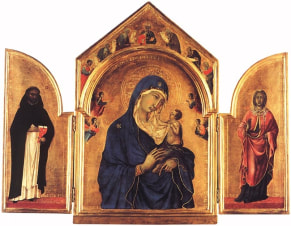 Duccio di Buoninsegna (d.1319), the Tuscan painter, chose to use real gold to represent stars and heaven in the altarpiece The Virgin and Child with Saints Dominic and Aurea. This portable altarpiece may have been commissioned by Cardinal Niccolò da Prato (d.1321), who was both a Dominican Friar and the Cardinal of Ostia. This would explain the saints on the wings of the triptych: Saint Dominic and Saint Aurea of Ostia. In the tympanum above the central panel are seven figures who have been identified as Old Testament prophets: Daniel, Moses, Isaiah, David, Abraham, Jacob and Jeremiah. They stand above a portrait of the Virgin Mary and the child Jesus, which is where Duccio has placed two stars; one on Mary’s shoulder and the other on the hood of her shawl. Duccio mixed gold leaf into his paint to draw these stars on top of the rich, blue egg tempera. The background of the entire wooden altarpiece was also painted in gold to represent the importance of heaven. The Adoration of the Kings – Gossaert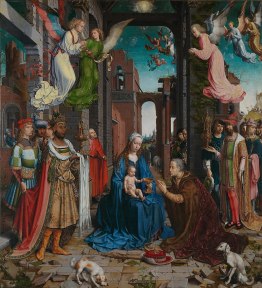 Of all the different genres of paintings, the one where you are guaranteed to find stars or at least a star are scenes of the Nativity. According to the Gospel of Matthew, wise men or magi followed a star from the East, which led them to a humble stable in Bethlehem. Paintings of this nature are often called The Adoration of the Kings or The Adoration of the Magi. Jan Gossaert (1478-1532) was one of many artists to depict this biblical scene. Mary, dressed in blue, sits with the Christ-child in the ruins of a building, receiving a gift from one of the “kings”. The Bible never mentioned the visitors were kings and nor did they have names. Art historians, however, have given this figure the traditional name Caspar. Melchior stands to the right of Caspar and Balthazar to the left. Alongside the “kings” are several exotically dressed attendants and more can be seen approaching in the distance. 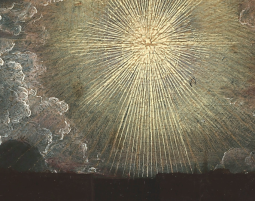 Floating above the scene are angels and right at the top, slightly dwarfed by everything else in the painting, is the Star of Bethlehem. The entire composition was painted on oak panels that when pieced together measured 177.2 cm (69.8 in) by 161.8 cm (63.7 in), and the star does not take up much space at all. Nonetheless, when studied closely, Gossaert’s precise brushstrokes and painstaking detail emphasise the importance of this star. Most likely painted in lead-tin-yellow, the star lights up the sky around it, appearing to push the surrounding clouds away so that it can shine over the Christ-child. The Adoration of the Kings – Carlo Dolci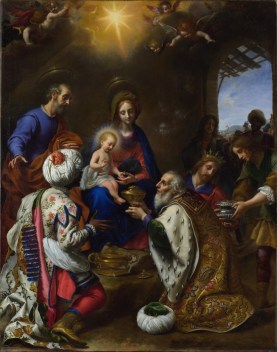 The star is much more prominent in the Baroque painter, Carlo Dolci’s (1616-86) version of the subject. This highly finished picture contains fewer people than Gossaert included, keeping the focus on the three “kings” in opulent robes as they kneel before Mary and the Christ-child. Although their gifts look important and expensive, they are executed in paint, whereas the haloes over Mary and Joseph and the light surrounding Jesus’ head was painted in gold. Although the figures and their robes were painted in rich colours, the Star of Bethlehem outshines them all. The star’s light bursts forth from the clouds above, making it the brightest part of the painting. When looking at the composition as a whole, the eye is constantly drawn upwards to the star, which some see as a symbol of God looking down on his precious son. The Adoration of the Kings – Filippino Lippi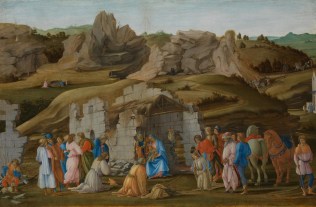 In contrast to the previous two paintings, Filippino Lippi’s (1457-1504) version contains a less obvious star, fading in the light of the daytime sky. Probably due to the star mentioned in Matthew’s Gospel, artists tended to portray the visit of the magi at night rather than during the day. Another difference between Lippi’s version and the traditional version is the landscape. The Holy Family sit in the ruins of a building in a rocky landscape. They have very little shelter and there appear to be no other establishments nearby. As well as the “kings” and their retinue, there are several saints hidden in the background. These have been identified as Mary Magdalene, Bernard of Clairvaux, Jerome and Augustine. There is also a representation of the Archangel Raphael and Tobias. 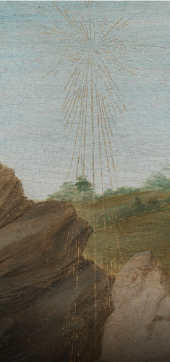 The way Lippi chose to portray the star is very different from the previous two examples. To begin with, it appears much lower in the sky, floating above the Holy Family. Rather than a solid or compact star, it resembles a firework. Lines of golden light appear to be shooting in all directions, some landing within touching distance of the figures below. Yet, this slightly faded star does not make it seem less important than other versions. The explosion of light beams emphasises God’s magnificent power that, although it is not easy to see in the daylight, is always there. Lippi’s painting was the last to feature in the National Gallery’s Star Trail. The handful of paintings they looked at revealed that stars have been important in science, mythology and religion. Of course, there are so many more examples of stars in the National Gallery and other locations. Each artwork demonstrates one method of representing stars. Some artists opt for a five-pointed star, whereas others choose a greater number. Alternatively, a star can be represented by a ball of light or the smallest of dots, as Turner chose. To read the full article, click here This blog post was published with the permission of the author, Hazel Stainer. www.hazelstainer.wordpress.com
|
©Copyright
We are happy for you to use any material found here, however, please acknowledge the source: www.gantshillurc.co.uk AuthorRev'd Martin Wheadon Archives
June 2024
Categories
All
|
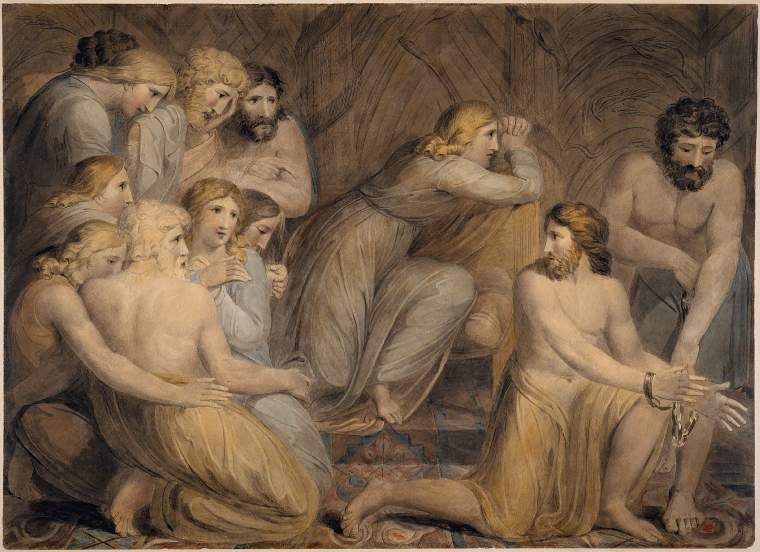
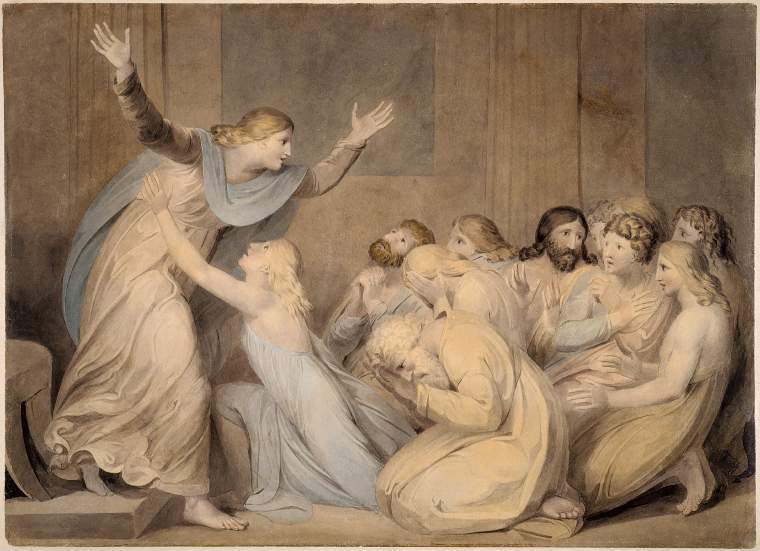
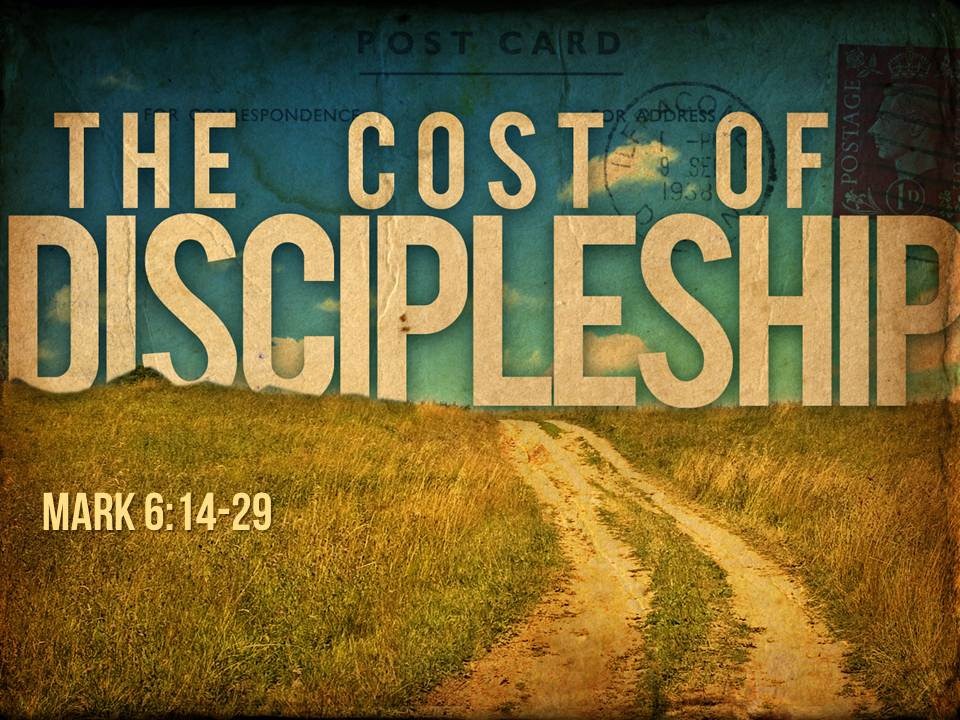
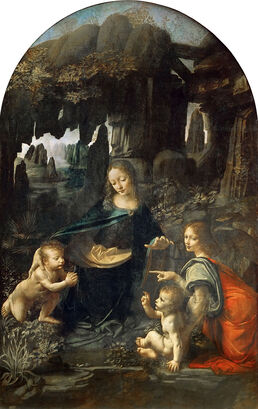
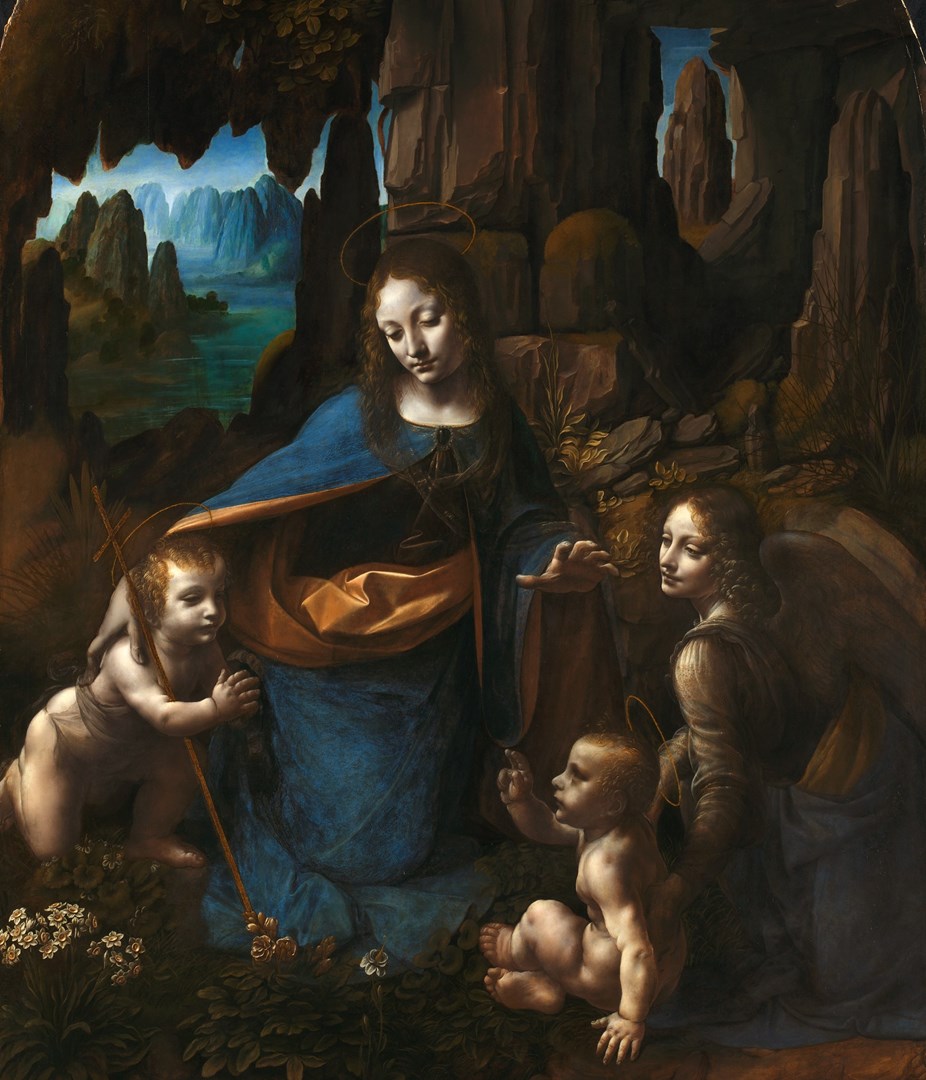

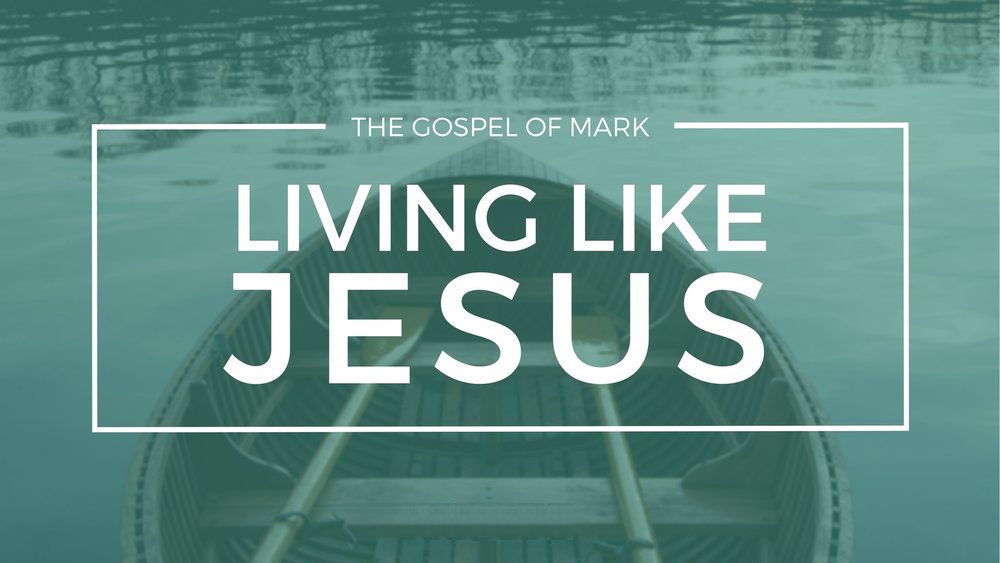
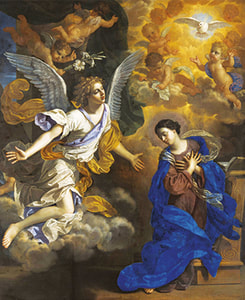
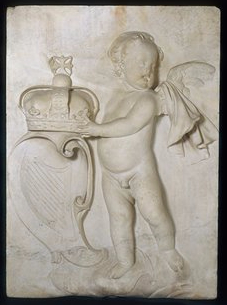

 RSS Feed
RSS Feed